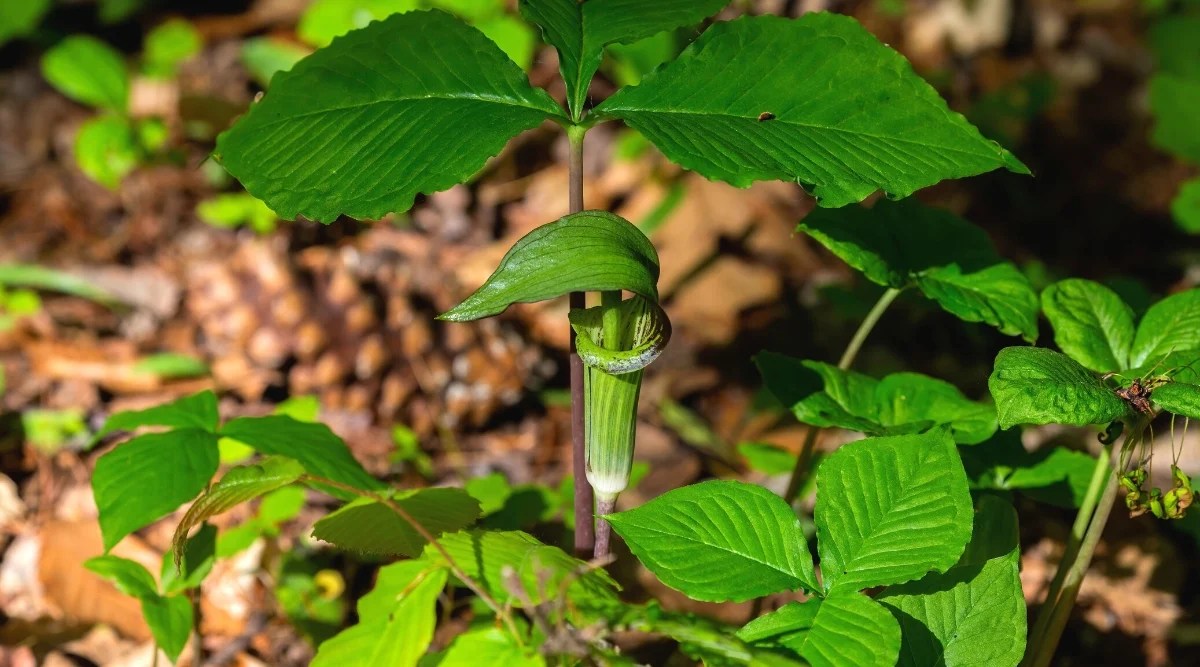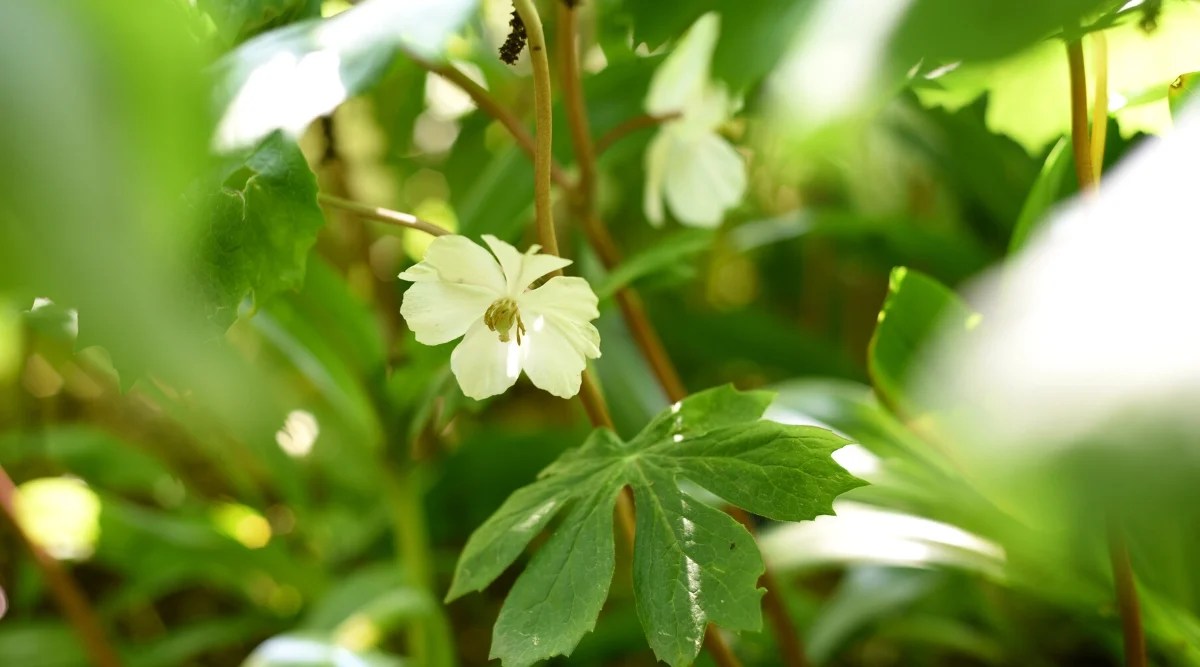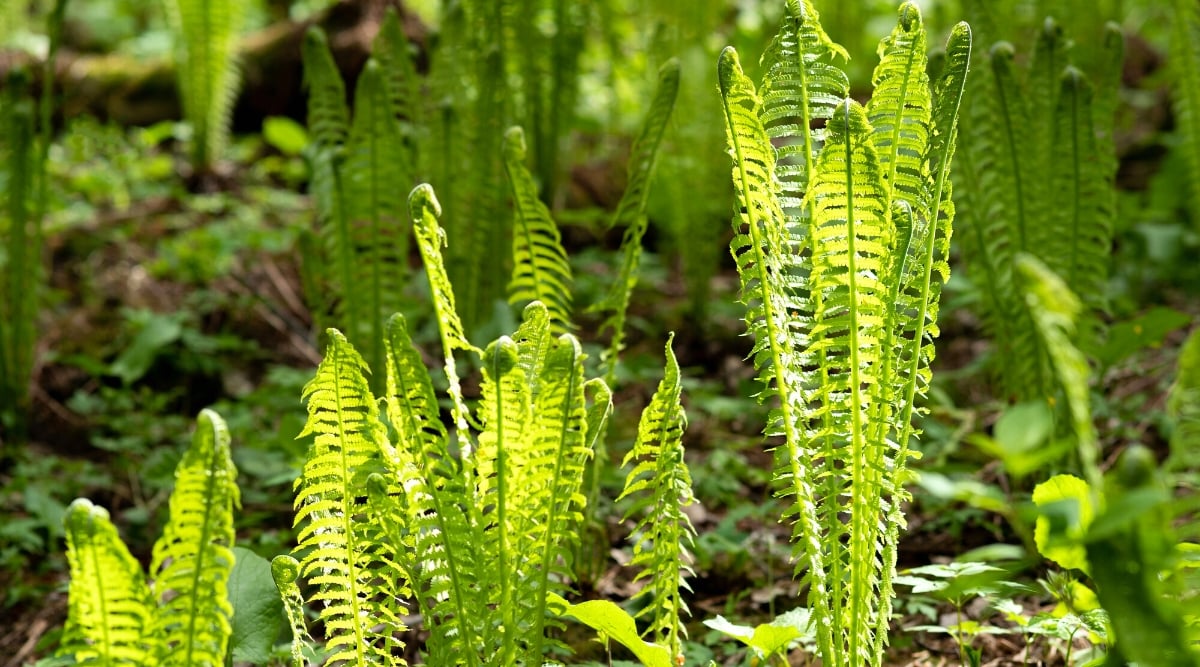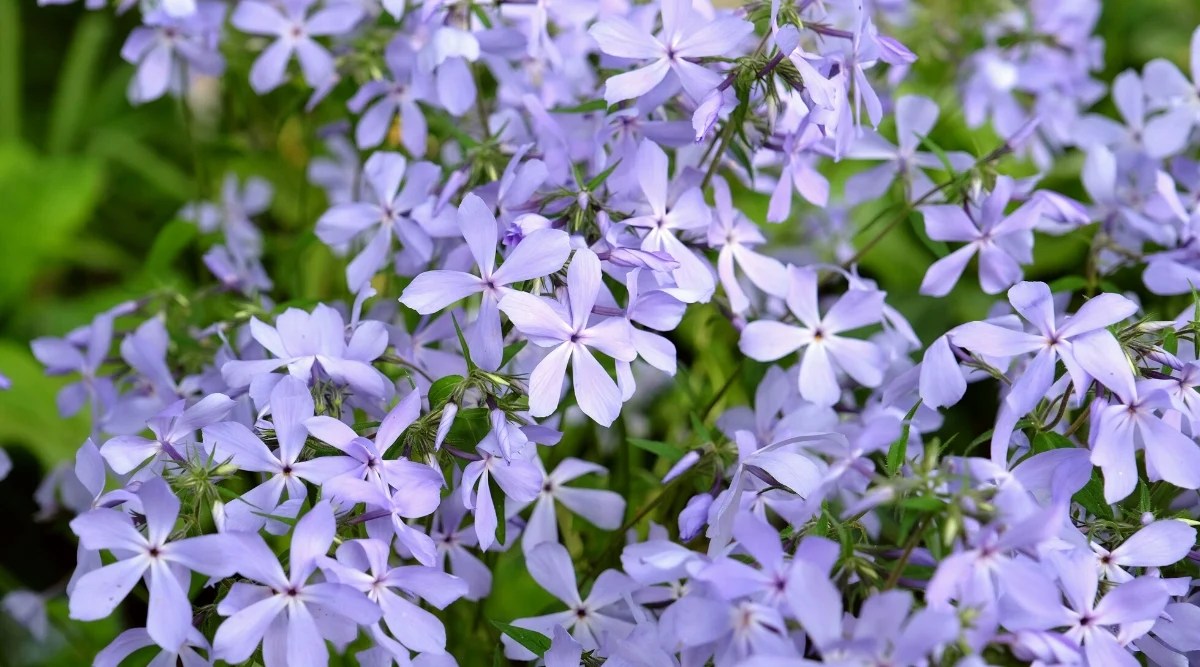Contents
If you have a landscape area shaded by trees or structures, these native plants for shade enjoy the reduced sunlight and even thrive on a bit of neglect. Native plants are eager to please with very little effort and will oftentimes thrive in areas with less sunlight, depending on the plant.
Native plants have adapted to the growing conditions of a specific region. No matter what your yard is like, as long as you can provide soil and water, there are native species that should grow well there. Many natives are not as well-known as the widely available commercial cultivars, but they make wonderful additions to the garden.
Gardening with native plants is beneficial because they:
- Are well-adapted to the local environment
- Provide food sources for native butterflies and pollinators
- Attract wild birds and local wildlife
- Are often deer-resistant
- Don’t require as much water as many non-native plants (many natives are drought tolerant)
- Don’t require the use of chemicals
- Provide environmental services
- Provide and enhance natural habitats
- Are beautiful!
Choosing native plants for shade is particularly beneficial because they can grow where many cultivated species cannot.
Many native plants can be grown from seed. Others can be purchased from specialized nurseries and reputable online companies. You can also divide dense clusters of plants from your gardening friends and neighbors. Just don’t dig plants from their natural habitats in the wild, as in many locations across the US, that’s illegal!
These 21 native shade plants won’t disappoint:
Christmas Fern

| BOTANICAL NAME | Polystichum acrostichoides |
| PLANT TYPE | Fern |
| SUN REQUIREMENTS | Part shade to full shade |
| HEIGHT | 1 to 2 feet |
| HARDINESS ZONES | 3 to 9 |
Ferns are beautiful plants that typically love the shade. Christmas fern tolerates some bright sunlight but grows best in partial or full shade. Give it a location with dry to medium moisture and well-drained soil. In ideal conditions, ferns are quite hardy and long-lived. They are also not bothered by deer or rabbits.
Ferns are non-flowering plants that offer gardeners beautiful foliage throughout the growing season and well into the winter months. In the springtime, the old foliage dies back, and a new batch of fern fiddleheads unfurls into a fresh growth of graceful fronds.
Clumps of Christmas ferns will get larger over time, and large clusters can be propagated by division.
Columbine

| BOTANICAL NAME | Aquilegia canadensis |
| PLANT TYPE | Herbaceous perennial |
| SUN REQUIREMENTS | Full sun to part shade |
| HEIGHT | 2 to 3 feet |
| HARDINESS ZONES | 3 to 8 |
Columbine, or wild columbine, is a wonderfully versatile wildflower. It grows very well in both full sun and partial shade, as long as it has some bright light during the day.
It is also not picky about soil quality as long as it is well-drained. Columbine is even flexible with moisture preferences. It does very well with consistent soil moisture yet tolerates dry soil and occasional drought.
When planting a shade garden or having a shady spot in need of some beautiful spring flowers, columbine is a great choice. The delicate-looking, almost fern-like foliage appears in early spring, followed by flowering stems. The stems rise above the basal foliage clumps and give way to beautiful red and yellow flowers.
The flowers are nodding, are a very unique shape, and attract early-season hummingbirds. After flowering, the foliage may decline rapidly in sunnier locations and is susceptible to powdery mildew. So it’s best to give each plant plenty of room to improve air circulation.
Foamflower

| BOTANICAL NAME | Tiarella cordifolia |
| PLANT TYPE | Herbaceous perennial |
| SUN REQUIREMENTS | Part shade to full shade |
| HEIGHT | 0.75 to 1 foot |
| HARDINESS ZONES | 4 to 9 |
Foamflower may not be a familiar plant for most gardeners, but it is well worth consideration for a shade garden. This plant loves a shaded location and can be grown in a shade garden or natural woodland area. Foamflower is not tolerant of drought and needs moist (not wet), well-drained soil. It is not bothered by deer or rabbits.
Foamflower is a low-growing, clump-forming perennial wildflower. You can use it as a ground cover or plant it along a border. In mild winters, the foliage may stay green year-round. In colder winters, the foliage will die back in the fall and regrow in the spring.
From mid-to-late spring, flower spikes with tiny clusters of white flowers make an attractive display.
Green and Gold

| BOTANICAL NAME | Chrysogonum virginianum |
| PLANT TYPE | Herbaceous perennial |
| SUN REQUIREMENTS | Part shade to full shade |
| HEIGHT | 0.5 to 1 foot |
| HARDINESS ZONES | 5 to 9 |
Green and gold is a beautiful little wildflower. It is low-growing and makes an excellent ground cover for a shaded location. Leaves are slightly fuzzy looking and grow in small rosettes.
In the springtime, beautiful 5-petaled bright yellow flowers appear, nestled closely among the leaves. In ideal conditions, plants may continue blooming sporadically throughout the summer and until the first frost, but the first spring bloom is typically the strongest.
Green and gold is a good choice for any moist shade garden. Because it is such a small plant, it would be best grown along a walkway or border to be seen and appreciated.
Remove spent flowers and browned stems to tidy up the appearance when your plants look ragged. Green and gold is a low-maintenance plant that is easily grown from seed.
Hairy Alumroot

| BOTANICAL NAME | Heuchera villosa |
| PLANT TYPE | Herbaceous perennial |
| SUN REQUIREMENTS | Full sun to part shade |
| HEIGHT | 1.5 to 2.5 feet |
| HARDINESS ZONES | 3 to 8 |
There are many beautiful commercially-available cultivars of the genus Heuchera, commonly known as coral bells. Hairy alumroot is a native variety of Heuchera found throughout the southeastern United States. It grows best in a shaded location with rich, moist, well-drained soil.
Hairy alumroot forms clumps of attractive foliage with somewhat maple-shaped leaves. The leaves may stay green in mild climates throughout the winter, but in colder climates, they will die back after the first frost and regrow in the following spring.
Tall spikes of tiny white flowers bloom in the spring. Plants will spread over time via underground runners, eventually forming a beautiful, natural ground cover.
Jack-in-the-Pulpit

| BOTANICAL NAME | Arisaema triphyllum |
| PLANT TYPE | Herbaceous perennial |
| SUN REQUIREMENTS | Part shade to full shade |
| HEIGHT | 1 to 2 feet |
| HARDINESS ZONES | 4 to 9 |
For something a bit different in your shade garden, try growing Jack-in-the-Pulpit. This plant emerges reliably with fresh growth each spring. Large, bright green, 3-lobed leaves appear at the end of each stem. In early to mid-spring, very unique, hooded, cup-shaped flowers bloom.
After flowering, mature plants may form an attractive cluster of fleshy green berries that turn bright red by mid-summer. Most of the leafy vegetation will die back by mid-to-late summer as the plant goes dormant.
Jack-in-the-pulpit loves a shaded garden plot and makes an excellent addition to a woodland shade garden. This plant is native throughout eastern North America, thriving in rich, moist soil.
Once established, Jack-in-the-pulpit is a reliable, low-maintenance plant to enjoy each spring. Mature plants will slowly spread by vegetative growth and by seed. Plants can be started from seed but are slow to mature.
Jacob’s Ladder

| BOTANICAL NAME | Polemonium reptans |
| PLANT TYPE | Herbaceous perennial |
| SUN REQUIREMENTS | Full sun to part shade |
| HEIGHT | 1 to 1.5 feet |
| HARDINESS ZONES | 3 to 8 |
Jacob’s ladder is a sweet spring-blooming wildflower native to the open woodlands of eastern North America. This plant grows well in full sun and partial shade. Soil should be rich in organic matter, medium moisture, and well-drained. Plants are easily grown from seed and are a beautiful addition to a shade garden.
Jacob’s ladder has delicate, fern-like foliage that looks best in the spring. The flowers are pale, purplish-blue, and bell-like, appearing in loose clusters at the ends of flowering stems. Flowers bloom in mid-to-late spring and attract early-season pollinators. Jacob’s ladder naturalizes well in ideal conditions and will spread by self-seeding to form large masses.
Large-Flowered Bellwort

| BOTANICAL NAME | Uvularia grandiflora |
| PLANT TYPE | Herbaceous perennial |
| SUN REQUIREMENTS | Part shade to full shade |
| HEIGHT | 1.5 to 2 feet |
| HARDINESS ZONES | 4 to 9 |
Large-flowered bellwort is a beautiful spring wildflower native to eastern and central North America. This plant is widespread and occurs naturally in many rich, moist woodlands. In the home landscape, grow large-flowered bellwort in a shade garden or any shaded corner with medium moisture soil. It looks nice growing with ferns and complements other woodland plants.
Large-flowered bellwort has long, gracefully-curved stems with elongated, alternate leaves. At a glance, the leafy stems are somewhat fernlike in appearance.
Bellwort blooms in the springtime. The flowers are nodding and bell-like with long yellow petals that help make this plant appear exceptionally graceful. Plants can be grown from seed or propagated by division. Plants will naturalize and spread by underground rhizomes.
Mayapple

| BOTANICAL NAME | Podophyllum peltatum |
| PLANT TYPE | Herbaceous perennial |
| SUN REQUIREMENTS | Part shade to full shade |
| HEIGHT | 1 to 1.5 feet |
| HARDINESS ZONES | 3 to 8 |
Mayapple is an early spring wildflower native to eastern North America. It is found naturally growing in rich, moist woodlands where its large, umbrella-like leaves are a common sight in early spring. Flowers are white and bloom singly underneath the leaves. After flowering, a small, rounded, green fruit may appear, giving rise to the name Mayapple.
After flowering and fruiting, the plants go dormant. The leaves will yellow and wither, fading away entirely by mid-summer. Mayapple provides plenty of early-season beauty, but grow it with companion plants like ferns that will last throughout the summer months.
Mayapple can be grown from seed or propagated by diving larger clusters. In optimal conditions, plants will naturalize and form large leafy colonies, providing a striking sight!
Northern Maidenhair Fern

| BOTANICAL NAME | Adiantum pedatum |
| PLANT TYPE | Fern |
| SUN REQUIREMENTS | Part shade to full shade |
| HEIGHT | 1 to 2.5 feet |
| HARDINESS ZONES | 3 to 8 |
The northern maidenhair fern is a beautiful fern that would make an excellent addition to any shade garden. It grows well in partial or full shade, staying green throughout the summer and dying back completely in the winter. Grow it in medium-moisture, well-drained soil. Deer and rabbits will not bother ferns.
Northern maidenhair fern looks dainty and delicate but is quite hardy and easy to grow. Long, thin, dark-colored stems appear in spring, topped with a cluster of small green fiddleheads. The fronds unfurl along a C-shaped upper stem, yielding a unique and beautiful structure. If maidenhair ferns are grown in too much sun, the fronds may brown and die back prematurely.
Ostrich Fern

| BOTANICAL NAME | Matteuccia struthiopteris |
| PLANT TYPE | Fern |
| SUN REQUIREMENTS | Part shade to full shade |
| HEIGHT | 3 to 6 feet |
| HARDINESS ZONES | 3 to 7 |
Ostrich fern is a large and impressive-looking fern. Grow it in a moist, shaded area with well-drained soil, and you will enjoy these beautiful plants all season long.
Be sure to plant your ostrich fern with room to grow and expand. They are not bothered by deer and rabbits and will naturalize and spread by underground rhizomes, creating colonies of greenery. Ostrich ferns prefer cooler climates, and the vegetation may die back prematurely in warmer climates.
Ostrich ferns can grow quite large. Each year, clusters of new fiddleheads emerge from the ground in the spring, slowly unfurling into full-size fronds. Each frond is lined with many alternate, deeply grooved pinnae. Fronds typically die back by late summer, and plants go dormant during winter.
Partridge Berry

| BOTANICAL NAME | Mitchella repens |
| PLANT TYPE | Broadleaf evergreen |
| SUN REQUIREMENTS | Part shade to full shade |
| HEIGHT | 0.00 to 0.25 feet |
| HARDINESS ZONES | 3 to 8 |
Ground covers are useful in many situations, but finding a truly ground-hugging plant isn’t always easy. Partridge berry creeps along the ground and rarely grows over a few inches tall.
It also is not aggressive and will not take over your garden with vegetative growth, so it is best grown in a small area. This is an ideal native plant for a shade garden with rich, moist soil.
Partridge berry grows low and stays low. The creeping stems are lined with pairs of opposite leaves that retain their dark green color throughout the year. In the spring, tiny, fragrant white flowers bloom along the stems. A few bright red berries will add a burst of color by mid-summer.
Solomon’s Seal

| BOTANICAL NAME | Polygonatum biflorum |
| PLANT TYPE | Herbaceous perennial |
| SUN REQUIREMENTS | Part shade to full shade |
| HEIGHT | 1 to 3 feet |
| HARDINESS ZONES | 3 to 8 |
Solomon’s seal is native to moist woodlands of central and eastern North America. It grows best in a well-shaded location and would be the perfect addition to a shade garden. Soil should be of average quality and high in organic matter. It prefers medium-moisture well-drained soil.
Solomon’s seal grows long upright stems lined with alternate leaves, looking vaguely fern-like. In early to mid-spring, the flowers appear along the underside of the stems.
Flowers are small, greenish-white, and bell-shaped, gracefully nodding beneath the leaves. In ideal growing conditions, plants will naturalize and spread slowly by underground rhizomes.
Spicebush

| BOTANICAL NAME | Calycanthus floridus |
| PLANT TYPE | Deciduous shrub |
| SUN REQUIREMENTS | Full sun to full shade |
| HEIGHT | 6 to 10 feet |
| HARDINESS ZONES | 4 to 9 |
Spicebush, also known as Carolina allspice or sweetshrub, is a medium-sized shrub that grows well in many sunlight conditions. It can thrive and bloom well anywhere from full sun to full shade. It does prefer moist, rich soil and is commonly found in moist forest bottomlands of the southeastern United States.
Spicebush blooms in spring or early summer. The flowers are a deep burgundy-red color and quite showy. The flowers are also very sweetly fragrant and attract butterflies and other insects.
Leaves turn an attractive yellow in the fall. In ideal conditions, spicebush will spread by root suckers. To prevent them from growing into a thicket, you can selectively prune or remove new growth to help control plant density.
Spring Beauty

| BOTANICAL NAME | Claytonia virginica |
| PLANT TYPE | Herbaceous perennial |
| SUN REQUIREMENTS | Part shade to full shade |
| HEIGHT | 0.25 to 0.75 feet |
| HARDINESS ZONES | 3 to 8 |
Now you see it; now you don’t! Spring beauty is one of the earliest spring wildflowers to bloom. Thin, grasslike leaves poke through the leaf litter in early spring, soon followed by delicate pink and white flowers.
After blooming, the leaves continue to grow until late spring. Even before the warm days of summer, spring beauty has already started to go dormant, the leaves browning and dying back until the following spring.
Spring beauty is native to the central and eastern United States, where it is found growing in moist woodlands. In the home landscape, it is a great plant for a shade garden, where its early spring blooms will welcome the growing season with a quick burst of color. Plants naturalize easily and will spread by underground tubers and self-seeding.
Sweet Pepperbush

| BOTANICAL NAME | Clethra alnifolia |
| PLANT TYPE | Deciduous shrub |
| SUN REQUIREMENTS | Part shade to full shade |
| HEIGHT | 3 to 8 feet |
| HARDINESS ZONES | 3 to 9 |
Sweet pepperbush is a small to medium-sized shrub. It is native to eastern and southern North America, where it is commonly found in moist woodlands.
This plant tolerates both full sun and full shade but prefers a location with partial shade. Grow it in medium to wet soil and prune root suckers, as desired, to prevent the formation of dense thickets.
Sweet pepperbush blooms in the summer months. The densely packed spikes of small white flowers are sweetly fragrant and attract many pollinators. Leaves turn yellow for excellent fall color. This plant would make a good hedge or accent plant along the edge of a pond or other moist area.
Virginia Bluebells

| BOTANICAL NAME | Mertensia virginica |
| PLANT TYPE | Herbaceous perennial |
| SUN REQUIREMENTS | Part shade to full shade |
| HEIGHT | 1.5 to 2 feet |
| HARDINESS ZONES | 3 to 8 |
Walking through the moist woodlands of eastern North America in spring, one may come across vast expanses of Virginia bluebells. This beautiful spring wildflower will also delight in the home garden. Virginia bluebells grow best in shaded areas with rich, moist, well-drained soil. Plants can be started from seed or divided into larger clusters.
Upright stems are lush and leafy early in the growing season. In early spring, pink buds form on the flowering stems, soon followed by beautiful blue, bell-shaped flowers that hang in nodding clusters.
Leaves persist for a short while after the flowers die back, and then the leaves wither and brown as the plant goes dormant through the summer, to re-emerge again the following spring. Grow Virginia bluebells with other shade-loving plants, such as ferns, that will be at their peak by mid-summer after the bluebells go dormant.
White Wood Aster

| BOTANICAL NAME | Eurybia divaricata |
| PLANT TYPE | Herbaceous perennial |
| SUN REQUIREMENTS | Part shade to full shade |
| HEIGHT | 1 to 2.5 feet |
| HARDINESS ZONES | 3 to 8 |
White wood aster is native to the forests of eastern North America. It is easy to grow and low maintenance in the home landscape. This attractive low-growing plant looks nice in a shaded garden plot. It prefers partial or full shade and a location with dry to medium-moisture, well-drained soil.
This aster will grow loose clumps of roughly heart-shaped leaves. It blooms delicate-looking white flowers in late summer or early fall.
The flowers attract butterflies and other pollinators. These plants are generally not bothered by browsing deer or rabbits. Dense clusters can be thinned to increase air circulation and reduce the risk of powdery mildew, especially in more humid environments.
Wild Ginger

| BOTANICAL NAME | Asarum canadense |
| PLANT TYPE | Herbaceous perennial |
| SUN REQUIREMENTS | Part shade to full shade |
| HEIGHT | 0.5 to 1 foot |
| HARDINESS ZONES | 3 to 7 |
Wild ginger is a fabulous plant for a shade garden. This wildflower is native to central and eastern North America and grows in moist woodlands. In the home garden, give it a shaded location with rich, moist, well-drained soil. It can tolerate a fair amount of sunlight and dry soil conditions.
Wild ginger is a low-growing plant that can form vast colonies and makes an excellent ground cover. It spreads by creeping rhizomes, and individual leaves emerge in small bunches directly from the base.
During the spring months, flowers bloom, but you have to look hard to find them. The flowers appear at ground level, directly at the base of the plant. The flowers are brownish-maroon and quite unique looking for anyone who takes the time to find them!
Wood Fern

| BOTANICAL NAME | Dryopteris marginalis |
| PLANT TYPE | Fern |
| SUN REQUIREMENTS | Part shade to full shade |
| HEIGHT | 1.5 to 2 feet |
| HARDINESS ZONES | 3 to 8 |
Wood fern, also known as the marginal wood fern or marginal shield fern, is a beautiful plant well-adapted to the shade garden. This fern grows best in partial to full shade with medium-moisture, well-drained soil. This is a low-maintenance plant that provides year-round greenery.
This is a medium-sized fern native to moist woodlands of central and eastern North America. This fern is evergreen and will provide garden interest throughout the year. In the springtime, new fronds will emerge with fresh green growth, while older fronds die back. This hardy and low-maintenance fern is easy to grow in the home landscape.
Woodland Phlox

| BOTANICAL NAME | Phlox divaricata |
| PLANT TYPE | Herbaceous perennial |
| SUN REQUIREMENTS | Part shade to full shade |
| HEIGHT | 0.75 to 1 foot |
| HARDINESS ZONES | 3 to 8 |
Woodland phlox is a beautiful spring-blooming wildflower. This plant is native to eastern North America, growing wild in moist woodlands. In the home garden, it is a great plant to add to a shade garden or any shaded area with rich, moist, well-drained soil.
Deer do not bother plants, but rabbits may find them a tasty snack. This phlox will tolerate occasional dry conditions.
Woodland phlox will spread and naturalize in ideal growing conditions. It can be grown from seed or by dividing established clusters. In the springtime, a mass of showy pale purple flowers blooms, providing delightful early-season color. The flowers are slightly fragrant and will attract early-season hummingbirds and butterflies.
Final Thoughts
If you have a shaded area and would like to grow native plants, you have a plethora of fabulous options. Select the best plants for your available site, considering the growing conditions you can provide.
For year-round beauty, choose a diversity of plants to fill your available space with four seasons of flower color and greenery. Don’t be afraid to try planting something new; many lesser-known native plants make wonderful additions to the home garden.